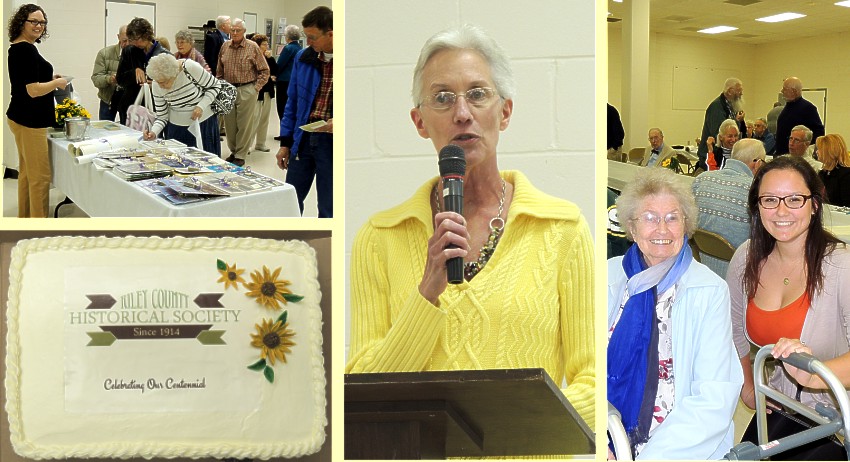Kansas Snapshots by Gloria Freeland - October 24, 2014
Eusebia would be proud!
I arrived a few minutes after several others. Their vehicles were by the entrance, trunks and side doors open. I
parked nearby and soon mine was like the others. Trip after trip followed as items were carried inside - juices, ginger
ale, a large punch bowl, tablecloths, Scotch tape, scissors, disposable tableware, sunflower arrangements, old
documents, a two-by-eight-foot plastic banner, and books and maps tied with purple and yellow ribbons. Two large
decorated sheet cakes, purple and yellow balloons, a guest book and an ice ring for the punch bowl arrived soon
after.
The big event was scheduled to start at 7 p.m. But when 6:45 rolled around, I began to wonder if any of our expected
guests were going to show up. Husband Art had come to help me take pictures and he had brought Mom for moral support.
But the tables and chairs for 100 people were looking pretty lonely. The day had been cloudy and the prospect for
rain may have scared folks into staying home.
Then people began arriving. Before long, the place was filled with happy chattering. Was I relieved!
It appeared our birthday party was going to be a success. And it wasn't just any birthday party. It was number 100
for the Riley County Historical Society. It had received its state charter on Oct. 12, 1914 - exactly 100 years to the
day of our celebration.
And as the 2014 president, it was my job to coordinate the whole affair while the real work was being completed by the
Riley County Historical Museum staff. Yet despite having done my fair share of special events, I'm always nervous
beforehand. And for a person who does not like the spotlight, it didn't help that one of my main tasks was to give a
presentation about the history of the society. Linda Glasgow, the museum's archivist, had spent days going through photos
and selected more than 120 for me. Art, who has helped me do several historical "shows" in the past, made the first cuts.
From there, I trimmed the number to around 70 to keep the presentation to about 15 minutes.
With this being the centennial year, it was natural to compare my life a bit to that of the society's first
president, Eusebia Mudge Irish. Her name always strikes me as being simultaneously rather dignified, yet also amusing.
While I'm a native Kansan, she had been born half a continent away in Lynn, Massachusetts almost 10 years before Kansas
became a state. Her father, Benjamin Mudge, was the first Kansas state geologist. Her mother, Mary Bickford, was
interested in archaeology and sciences. Eusebia had studied at Kansas State University, the Boston Conservatory of
Music and the University of Kansas and had married Frank Irish, a Manhattan attorney. For many years, she was Manhattan
High School's librarian.
While we both arrived here as young women, the city she experienced was very different from the one that greeted me
as a college student. In the city park is a log cabin built in 1915 using the same techniques and materials employed
by the area's pioneers. For some time, it served as the area's museum. At a meeting in 1929, Eusebia said, "The
original pioneers are mostly gone, but ... the log cabin museum is full and overflowing with relics ... Our history is
a sacred trust inherited from the pioneers; let us never cease to preserve it." Those words describe a part of the
mission of the society today as well as they did when she spoke them.
The current museum was opened in January 1977. It still owns the Pioneer Log Cabin, and over time, acquired the
Hartford House, one of the pre-fabricated homes brought to Manhattan on the Steamboat Hartford; the Wolf House Historic
Site; and Rocky Ford School.
But collecting and preserving alone aren't enough today. In these 100 years, we are far enough removed from those
pioneering days that youngsters and even some who aren't so young have only a vague idea of what life was like here on
the Kansas plains. So today the museum and historical society work together to share history through hands-on programs.
In the Wolf House, fourth graders learn how mattresses were made with corn husks and cotton ticking, how clothes were
washed in open tubs, how women cooked from scratch, and how Victorians decorated their parlors. In Rocky Ford School,
community members can experience what a school day was like for children in the early part of the 20th century. And
the museum building itself always seems to be "hopping" with visitors.
Museum staff and historical society volunteers also take history out into the community - through displays at the
courthouse, the mall, the Beach art museum and the Flint Hills Discovery Center. They visit schools and assisted
living centers.
So in the end, telling this story of the society's past and current efforts to a friendly audience proved easy. When
combined with cake, refreshments, door prizes and easy chatter, I think it is fair to say that the evening was a great
success and I'm confident Eusebia would have been proud!
